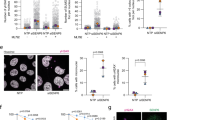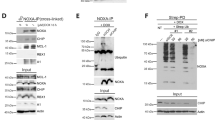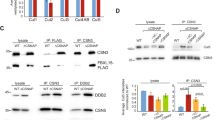Abstract
14-3-3σ, a gene upregulated by p53 in response to DNA damage, exists as part of a positive-feedback loop, which activates p53 and is a human cancer epithelial marker downregulated in various cancer types. 14-3-3σ levels are critical for maintaining p53 activity in response to DNA damage and regulating signal mediators such as Akt. In this study, we identify mammalian constitutive photomorphogenic 1 (COP1) as a novel E3 ubiquitin ligase for targeting 14-3-3σ through proteasomal degradation. We show for the first time that COP9 signalosome subunit 6 (CSN6) associates with COP1 and is involved in 14-3-3σ ubiquitin-mediated degradation. Mechanistic studies show that CSN6 expression leads to stabilization of COP1 through reducing COP1 self-ubiquitination and decelerating COP1's turnover rate. We also show that CSN6-mediated 14-3-3σ ubiquitination is compromised when COP1 is knocked down. Thus, CSN6 mediates 14-3-3σ ubiquitination through enhancing COP1 stability. Subsequently, we show that CSN6 causes 14-3-3σ downregulation, thereby activating Akt and promoting cell survival. Also, CSN6 overexpression leads to increased cell growth, transformation and promotes tumorigenicity. Significantly, 14-3-3σ expression can correct the abnormalities mediated by CSN6 expression. These data suggest that the CSN6-COP1 axis is involved in 14-3-3σ degradation, and that deregulation of this axis will promote cell growth and tumorigenicity.
This is a preview of subscription content, access via your institution
Access options
Subscribe to this journal
Receive 50 print issues and online access
$259.00 per year
only $5.18 per issue
Buy this article
- Purchase on Springer Link
- Instant access to full article PDF
Prices may be subject to local taxes which are calculated during checkout






Similar content being viewed by others
References
Bianchi E, Denti S, Catena R, Rossetti G, Polo S, Gasparian S et al. (2003). Characterization of human constitutive photomorphogenesis protein 1, a RING finger ubiquitin ligase that interacts with Jun transcription factors and modulates their transcriptional activity. J Biol Chem 278: 19682–19690.
Chamovitz DA, Wei N, Osterlund MT, von Arnim AG, Staub JM, Matsui M et al. (1996). The COP9 complex, a novel multisubunit nuclear regulator involved in light control of a plant developmental switch. Cell 86: 115–121.
Chan TA, Hermeking H, Lengauer C, Kinzler KW, Vogelstein B . (1999). 14-3-3Sigma is required to prevent mitotic catastrophe after DNA damage. Nature 401: 616–620.
Chen WS, Xu PZ, Gottlob K, Chen ML, Sokol K, Shiyanova T et al. (2001). Growth retardation and increased apoptosis in mice with homozygous disruption of the Akt1 gene. Genes Dev 15: 2203–2208.
Cope GA, Suh GS, Aravind L, Schwarz SE, Zipursky SL, Koonin EV et al. (2002). Role of predicted metalloprotease motif of Jab1/Csn5 in cleavage of Nedd8 from Cul1. Science 298: 608–611.
Dentin R, Liu Y, Koo SH, Hedrick S, Vargas T, Heredia J et al. (2007). Insulin modulates gluconeogenesis by inhibition of the coactivator TORC2. Nature 449: 366–369.
Dornan D, Bheddah S, Newton K, Ince W, Frantz GD, Dowd P et al. (2004a). COP1, the negative regulator of p53, is overexpressed in breast and ovarian adenocarcinomas. Cancer Res 64: 7226–7230.
Dornan D, Shimizu H, Mah A, Dudhela T, Eby M, O'Rourke K et al. (2006). ATM engages autodegradation of the E3 ubiquitin ligase COP1 after DNA damage. Science 313: 1122–1126.
Dornan D, Wertz I, Shimizu H, Arnott D, Frantz GD, Dowd P et al. (2004b). The ubiquitin ligase COP1 is a critical negative regulator of p53. Nature 429: 86–92.
Ferguson AT, Evron E, Umbricht CB, Pandita TK, Chan TA, Hermeking H et al. (2000). High frequency of hypermethylation at the 14-3-3 sigma locus leads to gene silencing in breast cancer. Proc Natl Acad Sci USA 97: 6049–6054.
Fu H, Subramanian RR, Masters SC . (2000). 14-3-3 proteins: structure, function, and regulation. Annu Rev Pharmacol Toxicol 40: 617–647.
Gusmaroli G, Figueroa P, Serino G, Deng XW . (2007). Role of the MPN subunits in COP9 signalosome assembly and activity, and their regulatory interaction with arabidopsis Cullin3-based E3 ligases. Plant Cell 19: 564–581.
Hardtke CS, Gohda K, Osterlund MT, Oyama T, Okada K, Deng XW . (2000). HY5 stability and activity in arabidopsis is regulated by phosphorylation in its COP1 binding domain. EMBO J 19: 4997–5006.
Hermeking H, Lengauer C, Polyak K, He TC, Zhang L, Thiagalingam S et al. (1997). 14-3-3 sigma is a p53-regulated inhibitor of G2/M progression. Mol Cell 1: 3–11.
Hoeller D, Hecker CM, Dikic I . (2006). Ubiquitin and ubiquitin-like proteins in cancer pathogenesis. Nat Rev Cancer 6: 776–788.
Horie-Inoue K, Inoue S . (2006). Epigenetic and proteolytic inactivation of 14-3-3sigma in breast and prostate cancers. Semin Cancer Biol 16: 235–239.
Karniol B, Chamovitz DA . (2000). The COP9 signalosome: from light signaling to general developmental regulation and back. Curr Opin Plant Biol 3: 387–393.
Laronga C, Yang HY, Neal C, Lee MH . (2000). Association of the cyclin-dependent kinases and 14-3-3 sigma negatively regulates cell cycle progression. J Biol Chem 275: 23106–23112.
Lee MH, Lozano G . (2006). Regulation of the p53-MDM2 pathway by 14-3-3 sigma and other proteins. Semin Cancer Biol 16: 225–234.
Li DQ, Ohshiro K, Reddy SD, Pakala SB, Lee MH, Zhang Y et al. (2009a). E3 ubiquitin ligase COP1 regulates the stability and functions of MTA1. Proc Natl Acad Sci USA 106: 17493–17498.
Li L, Deng XW . (2003). The COP9 signalosome: an alternative lid for the 26S proteasome? Trends Cell Biol 13: 507–509.
Li Z, Liu JY, Zhang JT . (2009b). 14-3-3sigma, the double-edged sword of human cancers. Am J Transl Res 1: 326–340.
Michaud NR, Fabian JR, Mathes KD, Morrison DK . (1995). 14-3-3 is not essential for Raf-1 function: identification of Raf-1 proteins that are biologically activated in a 14-3-3- and Ras-independent manner. Mol Cell Biol 15: 3390–3397.
Peng Z, Serino G, Deng XW . (2001). Molecular characterization of subunit 6 of the COP9 signalosome and its role in multifaceted developmental processes in arabidopsis. Plant Cell 13: 2393–2407.
Prasad GL, Valverius EM, McDuffie E, Cooper HL . (1992). Complementary DNA cloning of a novel epithelial cell marker protein, HME1, that may be down-regulated in neoplastic mammary cells. Cell Growth Differ 3: 507–513.
Qi L, Heredia JE, Altarejos JY, Screaton R, Goebel N, Niessen S et al. (2006). TRB3 links the E3 ubiquitin ligase COP1 to lipid metabolism. Science 312: 1763–1766.
Richardson KS, Zundel W . (2005). The emerging role of the COP9 signalosome in cancer. Mol Cancer Res 3: 645–653.
Savio MG, Rotondo G, Maglie S, Rossetti G, Bender JR, Pardi R . (2008). COP1D, an alternatively spliced constitutive photomorphogenic-1 (COP1) product, stabilizes UV stress-induced c-Jun through inhibition of full-length COP1. Oncogene 27: 2401–2411.
Su CH, Zhao R, Velazquez-Torres G, Chen J, Gully C, Yeung SC et al. (2010). Nuclear export regulation of COP1 by 14-3-3sigma in response to DNA damage. Mol Cancer 9: 243.
Su CH, Zhao R, Zhang F, Qu C, Chen B, Feng YH et al. (2011). 14-3-3[sigma] exerts tumor-suppressor activity mediated by regulation of COP1 stability. Cancer Res 71: 884–894.
Urano T, Saito T, Tsukui T, Fujita M, Hosoi T, Muramatsu M et al. (2002). Efp targets 14-3-3 sigma for proteolysis and promotes breast tumour growth. Nature 417: 871–875.
von Arnim AG, Deng XW . (1994). Light inactivation of arabidopsis photomorphogenic repressor COP1 involves a cell-specific regulation of its nucleocytoplasmic partitioning. Cell 79: 1035–1045.
Wang H, Ma LG, Li JM, Zhao HY, Deng XW . (2001). Direct interaction of arabidopsis cryptochromes with COP1 in light control development. Science 294: 154–158.
Wei N, Deng XW . (1992). COP9: a new genetic locus involved in light-regulated development and gene expression in arabidopsis. Plant Cell 4: 1507–1518.
Wei N, Deng XW . (2003). The COP9 signalosome. Annu Rev Cell Dev Biol 19: 261–286.
Wertz IE, O'Rourke KM, Zhang Z, Dornan D, Arnott D, Deshaies RJ et al. (2004). Human de-etiolated-1 regulates c-Jun by assembling a CUL4A ubiquitin ligase. Science 303: 1371–1374.
Yaffe MB, Rittinger K, Volinia S, Caron PR, Aitken A, Leffers H et al. (1997). The structural basis for 14-3-3:phosphopeptide binding specificity. Cell 91: 961–971.
Yang H, Wen YY, Zhao R, Lin YL, Fournier K, Yang HY et al. (2006). DNA damage-induced protein 14-3-3 sigma inhibits protein kinase B/Akt activation and suppresses Akt-activated cancer. Cancer Res 66: 3096–3105.
Yang H, Zhao R, Yang HY, Lee MH . (2005). Constitutively active FOXO4 inhibits Akt activity, regulates p27 Kip1 stability, and suppresses HER2-mediated tumorigenicity. Oncogene 24: 1924–1935.
Yang HY, Wen YY, Chen CH, Lozano G, Lee MH . (2003). 14-3-3 sigma positively regulates p53 and suppresses tumor growth. Mol Cell Biol 23: 7096–7107.
Yang HY, Wen YY, Lin YI, Pham L, Su CH, Yang H et al. (2007). Roles for negative cell regulator 14-3-3sigma in control of MDM2 activities. Oncogene 26: 7355–7362.
Yi C, Deng XW . (2005). COP1—from plant photomorphogenesis to mammalian tumorigenesis. Trends Cell Biol 15: 618–625.
Yi C, Li S, Chen X, Wiemer EA, Wang J, Wei N et al. (2005). Major vault protein, in concert with constitutively photomorphogenic 1, negatively regulates c-Jun-mediated activator protein 1 transcription in mammalian cells. Cancer Res 65: 5835–5840.
Zhao R, Yeung SC, Iwakuma T, Chen J, Su CH, Zhang XC et al. (2011). Impact of COP9 signalosome on MDM2-p53 axis in DNA damage-mediated apoptosis and tumorigenesis. J Clin Invest 121: 851–865.
Zou W, Zhang DE . (2006). The interferon-inducible ubiquitin-protein isopeptide ligase (E3) EFP also functions as an ISG15 E3 ligase. J Biol Chem 281: 3989–3994.
Acknowledgements
This work was supported by grants from the National Institutes of Health (NIH) (R01CA089266), Directed Medical Research Programs (DOD SIDA BC062166 to SJY and MHL) and Susan G Komen Breast Cancer Foundation (KG081048). This research was supported in part, by a cancer prevention fellowship for GVT (R25T CA57730). The University of Texas MD Anderson Cancer Center is supported by NIH core Grant CA16672.
Author information
Authors and Affiliations
Corresponding authors
Ethics declarations
Competing interests
The authors declare no conflict of interest.
Additional information
Supplementary Information accompanies the paper on the Oncogene website
Supplementary information
Rights and permissions
About this article
Cite this article
Choi, H., Gully, C., Su, CH. et al. COP9 signalosome subunit 6 stabilizes COP1, which functions as an E3 ubiquitin ligase for 14-3-3σ. Oncogene 30, 4791–4801 (2011). https://doi.org/10.1038/onc.2011.192
Received:
Revised:
Accepted:
Published:
Issue Date:
DOI: https://doi.org/10.1038/onc.2011.192
Keywords
This article is cited by
-
CSN6 promotes melanoma proliferation and metastasis by controlling the UBR5-mediated ubiquitination and degradation of CDK9
Cell Death & Disease (2021)
-
Regulation of p53 by the 14-3-3 protein interaction network: new opportunities for drug discovery in cancer
Cell Death Discovery (2020)
-
Correlation of constitutive photomorphogenic 1 (COP1) and p27 tumor suppressor protein expression in ovarian cancer
Genes & Genomics (2019)
-
HuCOP1 contributes to the regulation of DNA repair in keratinocytes
Molecular and Cellular Biochemistry (2017)
-
The cell cycle regulator 14-3-3σ opposes and reverses cancer metabolic reprogramming
Nature Communications (2015)



